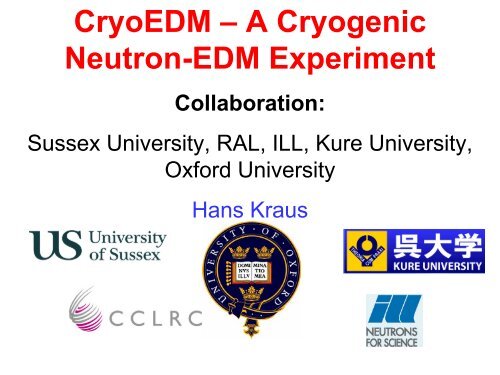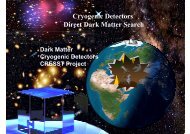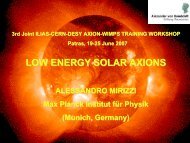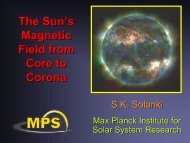The Search for an Electric Dipole Moment of the Neutron
The Search for an Electric Dipole Moment of the Neutron
The Search for an Electric Dipole Moment of the Neutron
Create successful ePaper yourself
Turn your PDF publications into a flip-book with our unique Google optimized e-Paper software.
CryoEDM – A Cryogenic<strong>Neutron</strong>-EDM ExperimentCollaboration:Sussex University, RAL, ILL, Kure University,Ox<strong>for</strong>d UniversityH<strong>an</strong>s Kraus
nEDM Overview• <strong>The</strong>oretical Background• <strong>The</strong> Method <strong>of</strong> Ramsey Reson<strong>an</strong>ce• Room-temperature Experiment• Ultra-Cold <strong>Neutron</strong>s• <strong>The</strong> Cryogenic Experiment
Fundamental InversionsC particle <strong>an</strong>tiparticle (Q → −Q)P position inverted (r →−r)T time reversed (t → −t)
SymmetriesWeak interactions are not P or C symmetric.Normal matter - n, μ, π - readily breaks C / P symmetry.<strong>The</strong> combination CP is different:Normal matter respects CP symmetry to a very highdegree.Time reversal is equivalent to CP (with CPT ok):Normal matter respects T symmetry to a very highdegree.
EDM breaks P <strong>an</strong>d T Symmetryneutron EDM:spindn=d sˆnP odd T odd+−P−++−T−+(P no big deal) (CP big deal)(assuming CPT invari<strong>an</strong>ce)
<strong>The</strong>oretical Overview• SM contribution is immeasurably small, but...• most models beyond SM predict values about10 6 greater th<strong>an</strong> SM. Very low background!• EDM measurements already constrainedSUSY models.• “Strong CP Problem”: Why does QCD notviolate CP? Nobody knows.• Finally, <strong>the</strong>re is <strong>the</strong> question <strong>of</strong> baryon – <strong>an</strong>tibaryonasymmetry in <strong>the</strong> universe.
Two Motivations to Measure EDMEDM violates T symmetryDeeply connected to CP violation <strong>an</strong>d <strong>the</strong>matter-<strong>an</strong>timatter asymmetry <strong>of</strong> <strong>the</strong>UniverseSt<strong>an</strong>dard model EDM is effectively zero, butbig enough to measure in non-st<strong>an</strong>dardmodelsDirect test <strong>of</strong> physics beyond <strong>the</strong> st<strong>an</strong>dardmodel
A Bit <strong>of</strong> HistoryA factor 10 improvementon average every 8years.Step ch<strong>an</strong>ge throughnew techniques.NowCryoEDM
<strong>The</strong> ILL in Grenoble
<strong>The</strong> <strong>Neutron</strong> Source<strong>Neutron</strong> turbineA. Steyerl (TUM - 1986)Vertical guide tubeCold sourceReactor core
Room Temperature ExperimentFour-layer mu-metal shieldQuartz insulatingcylinderMain storage cellHigh voltage leadCoil <strong>for</strong> 10 mGmagnetic fieldUpper electrodeHg u.v.lampPMT to detectHg u.v. lightVacuum wallMercuryprepolarising cellRF coil to flip spinsHg u.v. lampMagnetSNUCN guidech<strong>an</strong>geoverUCN polarising foilUltracoldneutrons(UCN)UCN detector
Measurement PrincipleMeasure Larmor spin precession frequencyin parallel & <strong>an</strong>tiparallel B <strong>an</strong>d E fields:BEd n makes precessionfaster...μ B... or slower.
Measurement PrincipleApply const magnetic field, reverse electric field:Δ W = 2μ ⋅ B + 2d⋅E↑↑Δ W = 2μ ⋅B − 2d⋅E↑↓nnnnν↑↑ν− = 4 d ⋅E/↑↓nhMeasure difference in precession frequency<strong>an</strong>d find <strong>Electric</strong> <strong>Dipole</strong> <strong>Moment</strong>
Ramsey’s Technique1.2.3.4.“Spin up”neutron...Apply π/2 spinflip pulse...Freeprecession...Second π/2 spinflip pulse.2 s130 s2 s
2400022000200001800016000140001200010000Ramsey Reson<strong>an</strong>cePhase gives frequency <strong>of</strong>fset from reson<strong>an</strong>ce.Spin-Up <strong>Neutron</strong> Countsxx xxReson<strong>an</strong>t freq.29.7 29.8 29.9 30.0 30.1Applied Frequency (Hz)x = working points
<strong>The</strong> Measurement
Mercury MagnetometryPolarized mercury atomsPMT
With Magnetometer
False EDM Signals∂ B1 vBrr=× E⇒ ∝B′2∂zγ cfrom div B = 0 from spec. rel.Different <strong>for</strong> 199 Hg <strong>an</strong>d neutronssee: Phys. Rev. A 70, 032102 (2004)Need <strong>for</strong> precise magnetometry
Room Temperature ResultsRoom temperature neutron EDM result:C.A. Baker et al., Phys. Rev. Lett. 97, 131801 (2006) or hep-ex/0602020|d n |< 2.9×10 -26 e.cm (90% C.L.)
CryoEDM – <strong>the</strong> new generationNew technology:• More neutrons• Higher E field• Better polarisation• Longer NMR coherence time100-fold improvement in sensitivity
Ultra-cold <strong>Neutron</strong> Productioncold neutronphononultra-cold neutronλ n = 8.9Å; E = 1.03meV1.03 meV (11K) neutrons down-scatter by emission <strong>of</strong>phonons in superfluid helium at 0.5KUp-scattering suppressed: hardly <strong>an</strong>y 11K phonons
Ultra-cold <strong>Neutron</strong> Productioncold neutronphononSingle-phononproductionultra-cold neutronMulti-phonon production1.19 ± 0.18 UCN cm −3 s −1 expected0.91 ± 0.13 UCN cm −3 s −1 observedC A Baker et al., Phys. Lett. A 308 (2002) 67
Ultra-cold <strong>Neutron</strong> Detection• ORTEC ULTRA at 430mK temperature.• Equipped with thin surface layer <strong>of</strong> 6 Li.• Using:n + 6 Li → α+ 3 H2.73 MeV Triton peakAlpha peakC.A.Baker et al., NIM A487 (2002) 511
<strong>The</strong> Cryogenic Setup<strong>Neutron</strong> beam inputCryogenicRamsey chamberSuperconducting shieldTr<strong>an</strong>sfer section
Superconducting Shield
Improvements on Statisticsσ =Dh /2αET NParameter RT Expt Sensitivity• Polarisation+detection α = 0.75 x 1.2• <strong>Electric</strong> field: E = 10 6 V/m x 4• Precession period: T = 130 s x 2• <strong>Neutron</strong>s counted: N = 6 x 10 6 /day x 4.5(with new beamline) x 2.6Total improvement: appr. x 100
SQUIDS from CRESSTSQUIDs <strong>for</strong> Magnetometry
Magnetometry Tests6Squid OP [V]54321SQUID 4SQUID 5Pickup LoopSQUIDs00 4 8 12 164 5Time [s]0.020.015SQUID 4 + SQUID 5Squid 4 + Squid 5 [V]0.010.0050-0.005-0.01Resolution 0.16 pT(1.6nG) @ 1Hz-0.015-0.020 4 8 12 16Time [s]
Ramsey Cell <strong>an</strong>d HV Stack
Reality CheckIf neutrons were <strong>the</strong> size <strong>of</strong> <strong>the</strong> Earth …+e-eΔx… <strong>the</strong>n current EDM limit me<strong>an</strong>scharge separation <strong>of</strong> Δx ≈ 1.5μm
Summary• After half a century, no sign <strong>of</strong> <strong>an</strong> EDM …• SUSY being squeezed. Ever-tighter limitscontinue to constrain physics beyond SM.• Room-temperature experiment finished.• CryoEDM: under way with aim <strong>of</strong> ~100improvement in sensitivity.






